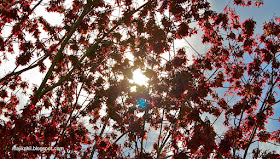
Spring has bloomed and we've moved directly into early summer here at 28.5° N. The Red maples were spectacular for a couple days but the current heat is making their red fall quickly and change into green (above and below). These specimen are better known scientifically as Acer rubrum L. var. trilobum Torr. & A. Gray ex K. Koch.

While it warmed quickly here in Central Florida it is nothing like the incredible 110° temperature swing that Okalahoma has experienced in the past week.
WILDEST TEMPERATURE SWING EVER RECORDED?
The temperature in Bartlesville, Oklahoma shot up to a record 82°F (28°C.) Saturday, just seven days after the city hit -28°F (-33° C.) on February 10. This 110° F. temperature change has to be one of the greatest 1-week temperature swings in U.S. history. The -31°F that was recorded in nearby Nowata last week has now been certified by the National Weather Service as the new official all-time coldest temperature ever recorded in Oklahoma. What's more, the 27 inches of snow that fell on Spavinaw, Oklahoma during the February 8 - 9 snowstorm set a new official state 24-hour snowfall record.
A 100+ degree Fahrenheit temperature change in just six days is a phenomenally rare event. I checked the records for over twenty major cities in the Midwest in Oklahoma, Texas, Kansas, Wyoming, Nebraska, South Dakota, North Dakota, and Montana, and could not find any examples of a 100-degree temperature swing in such a short time period. The closest I could find was a 108° F. swing in temperature in fourteen days at Valentine, Nebraska, from -27°F (-33° C.) on March 11, 1998 to 82°F (28° C.) on March 25, 1998. Valentine also had a 105°F temperature swing in fifteen days from November 29, 1901 (71°F) to December 14, 1901 (-34°F.).
Today its in the mid-80°s (27-29° C.) here in Central Florida. Uncomfortably warm, but not unprecedented for this latitude.
Below: I love Cupid's Shavingbrush or the Florida tassel flower (also known as (Emilia fosbergii Nicolson). Its a delicate wildflower that paints the landscape pink and red above normally wet locations, like the berm of our now-dry lake.

Below: Where there is still some water in the lake the Floating Bladderwort (Utricularia cornuta) are trying to survive. They will dry and die soon and perhaps come back when/if it rains. . . or next spring. I found this one specimen in a little puddle about 1,000' (305 meters) out from the 'normal' shoreline of our lake. . . in tiny puddle of water.

Below: I have a few white "Alabama" azalea (Rhododendron alabamense Rehder) surviving from the originals I planted in 1995. I tired quickly of this native plant that only blooms for a week or two at this latitude. I moved them from the front of the house to alongside one of the big ponds in back, and I'm always surprised when I see them flower in spring. . . surprised that they're still hanging on. These native azaleas are in the Heath family (Ericaceae) and are sometimes referred to by their Genus: Rhododendron. What one would buy in a garden center are more likely Japanese azalea (Rhodendendron japonicum (A. Gray) Sur.) or Carolina azalea (Rhodendendron carolinianum Rehder), close cousins to this hearty native species.

No comments:
Post a Comment